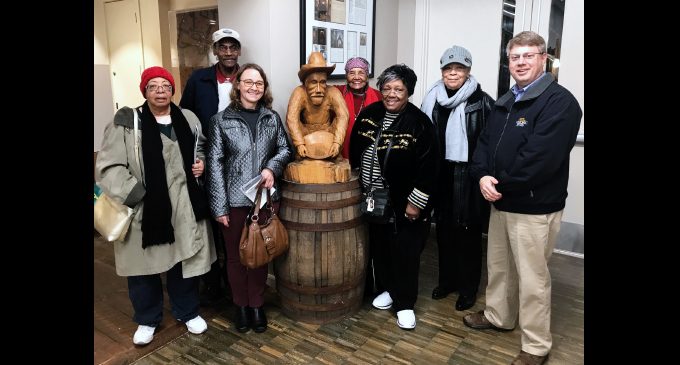Seniors group tours Reed Gold Mine

By Judie Holcomb-Pack
Despite the steady rain on Saturday, Feb. 23, six ladies from the Salvation Army’s senior center had a fun day learning about the Reed Gold Mine. The Reed Gold Mine is located in Midland, near Charlotte, and is the first documented gold find in America. This was the first of hundreds of mines that sprang up in North Carolina before the California Gold Rush. The historical site presented a program “North Carolina Slavery and the Reed Gold Mine” during February, Black History Month. Larry Neal, historical site manager, gave the presentation before taking the group on a tour of the mine.
Kelly Stallato, Salvation Army senior program director, said there was so much interest in the trip that she had to arrange two tour groups to the mine. This is one of several monthly day trips that Kelly organizes for the senior center members.
During the presentation, Neal noted that John Reed was a Hessian soldier who came to America as a paid soldier to fight for the British in the Revolutionary War. In 1782 he deserted the British Army and made his way to North Carolina because there was a large group of Germans living here. He became a farmer, working on land as a tenant until he could afford to buy land of his own. As the story goes, in 1712 his 12-year-old son Conrad found a large shiny rock that for many years was used as a door stop. In 1802, he took the rock to a jeweler in Fayetteville who determined the rock was actually a large gold nugget. Reed sold the gold nugget for $3.50, a week’s wage for a farmer; the actual value was $3,600 in 1800 dollars!
Reed started a partnership with three neighbors to start mining for gold on the land around his farm. Although Reed didn’t own slaves at that time, his neighbors did and the slaves were used to work in the gold mine. In the beginning, placer pits or holes were dug about five feet down where the gold could be dug out with a shovel. In 1831 the Reed Gold Mine was built, which went about 50 feet below ground. The tunnels in the mine were just five feet high and two to three feet wide, so miners had to work stooped over for up to 12 hours a day. There wasn’t electricity at that time, so the mines were lit with candles and the miners wore helmets that held candles on the top so they could see. The work was backbreaking and hazardous. Slave women and children also worked at the mine, but they worked on the surface, while the men worked under ground. Slave labor was crucial to the success of the mining operation because white people would not do that kind of work. Reed eventually owned 19 slaves that he used to work in the mine, but during crop season in April to harvest time in October, the mine closed so that the slaves could work in the fields, which was more profitable.
John Reed died in 1845 and the mine stayed closed for ten years. The mine was sold and reopened and operated until 1912. It was later sold to Warren Kelly and in 1971 the Kelly family donated it to the State of North Carolina as a historical site.
Although it was a wet and dreary day, the seniors braved the rain and cold to walk through the mine tunnels and learn about this interesting part of black history in North Carolina.
For more information about the Salvation Army senior center, email Kelly Stallato at Kelly.Stellato@uss.salvationarmy.org. For information on the Reed Gold Mine, visit www.nchistoricsites.org/reed.htm.















